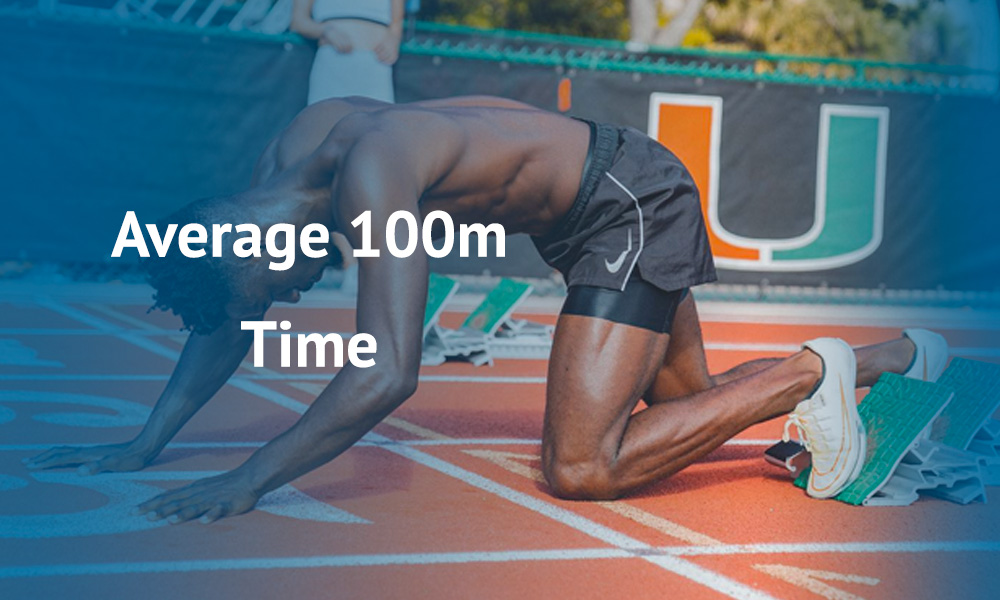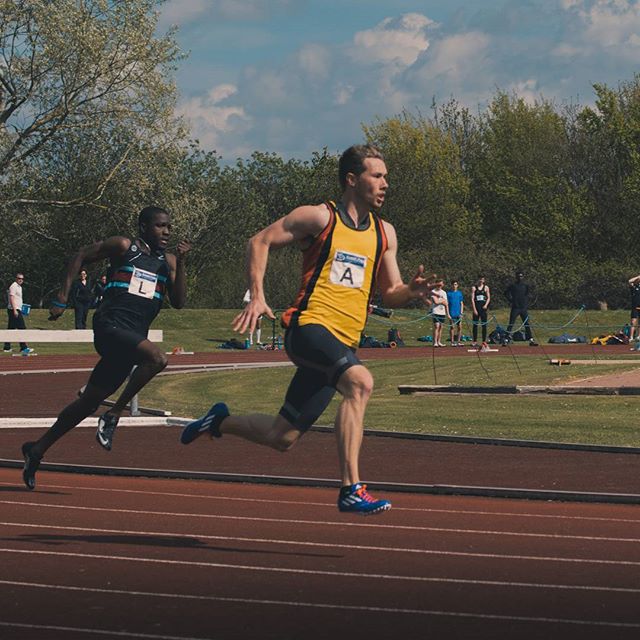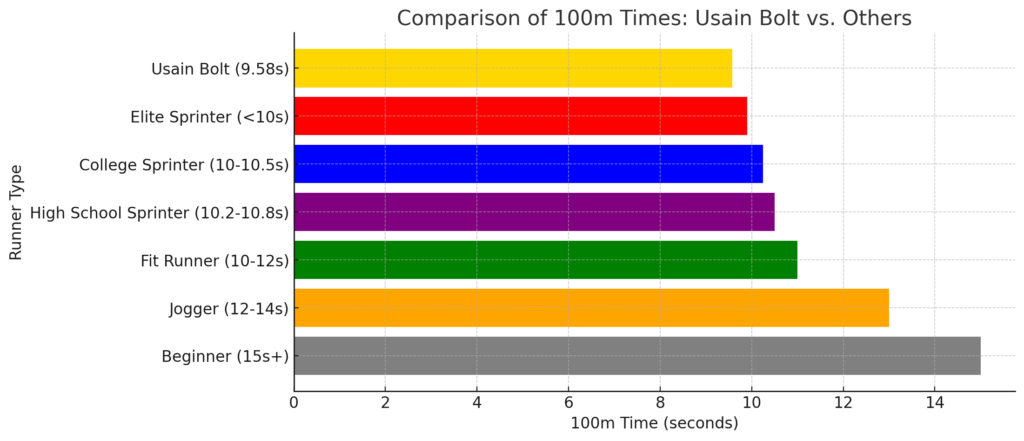Other Posts
- October 8, 2024The long jump has always…
Running Hashtags: How To Get More Social Media Followers
February 21, 2022Running hashtags is a great…


Ever wondered how your 100m sprint time stacks up against the competition? Whether you’re a casual runner, a high school athlete, or someone simply curious about elite speeds, the 100-meter dash is one of the best tests of pure speed and power.
As the most-watched race in the Olympics, the 100m sprint has crowned legends like Usain Bolt and Florence Griffith-Joyner, setting world records that seem almost untouchable. But what about the everyday runner? How does your time compare to the average for your age and experience level?
In this post, we’ll break down:
Let’s dive in and find out where you rank!
When it comes to sprinting, “good” is relative—your 100m time depends on factors like age, training level, and competition experience. A recreational runner’s time will be vastly different from that of a competitive sprinter, just as a teenager’s speed will differ from an adult’s.
At the elite level, Usain Bolt holds the world record with a jaw-dropping 9.58 seconds, set at the 2009 World Championships. For most people, even breaking 12 seconds is considered exceptional. But where do you fit in?
Here’s a general breakdown of 100m sprint times by experience level:
Table of Contents
| Category | Men (Seconds) | Women (Seconds) |
|---|---|---|
| Elite Sprinters (Olympic level) | 9.5 – 10.5 | 10.5 – 11.5 |
| College Athletes | 10.5 – 11.5 | 11.5 – 12.5 |
| High School Varsity | 11.5 – 12.5 | 12.5 – 14.0 |
| Recreational Runners | 12.5 – 15.0 | 14.0 – 17.0 |
Times are populated using power of 10 and world athletics rankings.
Times will also vary by age—younger sprinters may not have developed full strength and technique, while older runners may see declines in speed.
So what’s a good 100m time for you? If you’re breaking 12 seconds as an amateur, you’re in elite company. If you’re around 13-15 seconds, you’re faster than the average person. But no matter where you start, training and technique can help you improve.
Next, let’s break down the factors that impact your sprint time and how you can improve your speed. 🚀
Your 100m sprint time isn’t just about raw speed—it’s influenced by a combination of biology, training, technique, and external conditions. Let’s break down the key factors that determine how fast you can run.
Some aspects of sprinting ability are determined by genetics, giving certain athletes a natural edge. Key biological factors include:
📝 Takeaway: While genetics play a role, proper training can maximize your speed regardless of your natural attributes.
Sprinting isn’t just about running—it’s about power, explosiveness, and endurance. The right training program can shave seconds off your time.
📝 Takeaway: Sprinting speed isn’t just about running—it’s about developing full-body power, speed endurance, and explosiveness.
Even the strongest sprinter will be slower with poor technique. Proper mechanics are key to maximizing speed.
📝 Takeaway: Drilling proper sprint mechanics is just as important as strength training—small tweaks can lead to major improvements.
External factors can play a big role in sprint performance—some race times are even invalidated if wind assistance is too high.
📝 Takeaway: While you can’t control the weather, choosing the right track conditions and optimizing race-day preparation can help you run your fastest.
Speed isn’t just about running—it’s about explosiveness, technique, and strength. Whether you’re a beginner or an experienced sprinter, a structured training approach can help you cut down your 100m time. Here’s how to optimize your speed in four key areas.
Improving acceleration, stride efficiency, and mechanics is crucial for shaving off time.
📝 Takeaway: Acceleration and mechanics set the foundation for top-end speed. Drilling efficient movement helps reduce wasted energy.
Sprint speed is powered by explosive strength—building leg, core, and hip power is essential.
📝 Takeaway: Speed comes from strength. A power-based strength program enhances ground force production and stride efficiency.
A structured weekly training plan combines sprint work, strength training, and recovery for optimal results.
DayFocusWorkouts
Monday Sprint Mechanics + Acceleration Block Starts, Sled Sprints, Strength Training (Squats, Deadlifts)
Tuesday Speed Endurance Floating Sprints, Bounding, Plyometrics
Wednesday Recovery & Mobility Light jogging, mobility work, core exercises
Thursday Max Velocity Sprinting Overstride Runs, Flying 30m Sprints, Strength Training (Single-leg focus)
Friday Sprint Power & Explosiveness Hill Sprints, Depth Jumps, Hurdle Hops
Saturday Active Recovery Pool workouts, yoga, foam rolling
Sunday Rest Full recovery & nutrition focus
📝 Takeaway: Following this progressive plan for 4-6 weeks can significantly improve your acceleration, stride power, and overall speed.
Even the fastest sprinters can lose valuable time due to inefficient technique and training errors. Here are some of the most common mistakes that slow down 100m times—and how to fix them.
The first 30 meters of a 100m sprint are crucial—if your start is weak, you’ll spend the rest of the race playing catch-up.
❌ Common Mistakes:
✅ Fix It:
✔ Perfect your block setup: Ensure your rear foot is about 2 feet behind your front and your hips are slightly higher than your shoulders.
✔ Use an explosive arm drive: Your arms should punch forward aggressively to help generate momentum.
✔ Train reaction time: Use audio cues or have a coach yell “Go!” randomly to simulate a race start.
📝 Takeaway: A slow start can add 0.2-0.4 seconds to your time—mastering acceleration is key.
Many sprinters try to take longer strides, thinking it will cover more ground faster. In reality, overstriding slows you down by increasing ground contact time.
❌ Common Mistakes:
✅ Fix It:
✔ Shorten your ground contact time: Land with your foot directly under your hips to maintain speed.
✔ Increase stride frequency: Work on quick, controlled steps rather than forcefully stretching your legs forward.
✔ Use sprint drills like A-Skips & B-Skips to reinforce proper foot placement.
📝 Takeaway: An efficient stride means covering more ground with less energy—overstriding slows momentum.
Sprinting is all about force production—if you lack power, your speed potential is limited.
❌ Common Mistakes:
✅ Fix It:
✔ Incorporate heavy strength training: Squats, deadlifts, and power cleans develop sprint power.
✔ Do plyometric drills: Exercises like depth jumps, bounding, and sled sprints improve explosiveness.
✔ Focus on posterior chain strength: Strong hamstrings and glutes are essential for top speed.
📝 Takeaway: More power = greater acceleration = a faster 100m time.
Flexibility and recovery are often overlooked but are essential for maintaining sprint efficiency and preventing injuries.
❌ Common Mistakes:
✅ Fix It:
✔ Stretch daily: Incorporate dynamic stretches before sprinting and static stretches after workouts.
✔ Use foam rolling & mobility work: Focus on the hip flexors, hamstrings, and calves to maintain stride efficiency.
✔ Get enough rest: Aim for 7-9 hours of sleep per night and refuel with protein & carbs post-workout.
📝 Takeaway: A flexible, well-recovered sprinter is a fast sprinter—don’t neglect mobility work.
The 100-meter dash is the ultimate test of speed, and elite sprinters push the limits of human performance. But how do their times compare to the average person? Let’s break it down.
At the highest level, sprinters race at speeds over 27 mph (43 km/h), covering 100 meters in under 10 seconds. The difference between elite, amateur, and casual runners is staggering.
| Runner Type | 100m Time (Seconds) | Speed (mph/kmh) |
|---|---|---|
| Usain Bolt (World Record) | 9.58s | 27.8 mph / 44.7 km/h |
| Elite Sprinters (Olympic Level) | 9.8 – 10s | 26+ mph / 42+ km/h |
| College Sprinter | 10.2 – 10.5s | 24-25 mph / 38-40 km/h |
| High School Sprinter | 10.5 – 10.8s | 22-24 mph / 35-38 km/h |
| Fit Runner (Active Athletes) | 10-12s | 19-21 mph / 30-34 km/h |
| Jogger (Recreational Runner) | 12-14s | 16-18 mph / 26-29 km/h |
| Beginner (Casual/Untrained) | 15+ seconds | 14 mph / 22 km/h or less |

Usain Bolt’s 9.58s world record means he finishes 100m in the time it takes an average jogger to reach 60-70m!
🔹 He is nearly 2 seconds faster than the best high school sprinters.
🔹 He would finish a full 5+ seconds ahead of the average person.
💡 Fun Fact: If you were running against Bolt in a 100m race, by the time you crossed the 70m mark, he’d already have won!